-
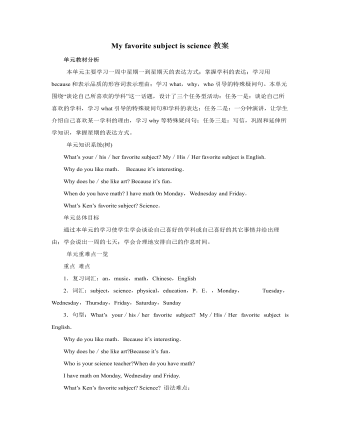
人教版新目标初中英语七年级上册My favorite subject is science教案
本单元主要学习一周中星期一到星期天的表达方式;掌握学科的表达;学习用because和表示品质的形容词表示理由;学习what,why,who引导的特殊疑问句。本单元围绕“谈论自己所喜欢的学科”这一话题,设计了三个任务型活动:任务一是:谈论自己所喜欢的学科,学习what引导的特殊疑问句和学科的表达;任务二是:一分钟演讲,让学生介绍自己喜欢某一学科的理由,学习why等特殊疑问句;任务三是:写信,巩固和延伸所学知识,掌握星期的表达方式。单元知识系统(树)What’s your/his/her favorite subject? My/His/Her favorite subject is English.Why do you like math. Because it’s interesting.Why does he/she like art? Because it’s fun.When do you have math? I have math 0n Monday,Wednesday and Friday.What’s Ken’s favorite subject? Science.单元总体目标通过本单元的学习使学生学会谈论自己喜好的学科或自己喜好的其它事情并给出理由;学会说出一周的七天;学会合理地安排自己的作息时间。

人教版新目标初中英语八年级上册Can you come to my party教案3篇
Step 3 (3b)First, tell the students when we talk about our future plans, we often use: I’m+verb+ing When we talk about what we must do, we use have to. Ask the students to fill in the blanks in 3b. The answers are: shopping, go to see, a test, I’m going, my family. Step 4 (3c)Let the students write an e-mail message to a friend. Say why you can’t visit next. Before the exercise, ask the students to give some possible answers and write them on the blackboard. So the students will feel easy to finish the writing exercise. After they finish it, Let them to correct it in groups first. Each group chooses theirs best one to read in front of the whole class. Step 5 ( planning a party )First read the conversation in the box together. Then ask the students to turn to page 88.Write down everything you have to do next week. Write in all the things you have to do . Ask the students to look at the list. Ask them “What day are you free?” This is when you can have your party. Step 6 (Self check 1 )Let the students to fill in the blanks with the words given. Change the forms of the words if possible. Then make their own sentences. The answers are: visit, playing, have to, study, comeStep 7 (Self check 2)Imagine you are Marie. Read the information and look at your schedule. Write replies to the invitation.

人教版新目标初中英语八年级上册How do you make a banana milk shake教案2篇
1. First, ... then, ... next, ... finally, ...首先,……然后,……接着,……最后,……这是英语中表达做某事的步骤的一种说法。如果步骤较多,还可以说:first-next-after that-later on-finally/at last通常你会听到说英语国家的人在说 first, next, then, finally 和后面的内容时,他们会做一些停顿。这样就能提前告诉听者接下来讲的是一系列的步骤。这一点在朗读和听力中应特别注意。2. how many, how much均为疑问词,同是“多少”,但用法不同。请看:how many修饰可数名词复数,how much修饰不可数名词。但在用法上,同学们常犯如下错误:1) [误] How many are there bananas on the table?[正] How many bananas are there on the table?[析] how many, how much 中的many,much是形容词,常修饰名词作定语,故后面跟名词。2) [误]How much tea are there on the table?[正]How much tea is there on the table?[析] how much修饰不可数名词时,谓语动词用单数。how many与how much的区别可简记为:前how many:问“多少”,复数名词后面跑;how much问“多少”,不可数名词单数好。前者答语用基数词,后者答语用数量关系。
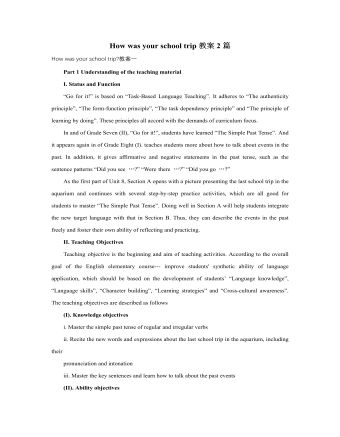
人教版新目标初中英语八年级上册How was your school trip教案2篇
“Go for it!” is based on “Task-Based Language Teaching”. It adheres to “The authenticity principle”, “The form-function principle”, “The task dependency principle” and “The principle of learning by doing”. These principles all accord with the demands of curriculum focus.In and of Grade Seven (II), “Go for it!”, students have learned “The Simple Past Tense”. And it appears again in of Grade Eight (I). teaches students more about how to talk about events in the past. In addition, it gives affirmative and negative statements in the past tense, such as the sentence patterns “Did you see …?” “Were there …?” “Did you go …?” As the first part of Unit 8, Section A opens with a picture presenting the last school trip in the aquarium and continues with several step-by-step practice activities, which are all good for students to master “The Simple Past Tense”. Doing well in Section A will help students integrate the new target language with that in Section B. Thus, they can describe the events in the past freely and foster their own ability of reflecting and practicing. II. Teaching ObjectivesTeaching objective is the beginning and aim of teaching activities. According to the overall goal of the English elementary course--- improve students' synthetic ability of language application, which should be based on the development of students’ “Language knowledge”, “Language skills”, “Character building”, “Learning strategies” and “Cross-cultural awareness”. The teaching objectives are described as follows(I). Knowledge objectivesi. Master the simple past tense of regular and irregular verbsii. Recite the new words and expressions about the last school trip in the aquarium, including their pronunciation and intonation

人教版新目标初中英语八年级上册Could you please clean your room教案3篇
一、 教学内容Section A 1a----1c二、 教学目标1.学习词汇do the dishes, make the bed, take out the trash, fold the clothes, do the laundry, sweep the floor, clean the living room.2.句型 Could you please clean your room? Yes, sure.三、 教学准备 学生预习本单元所有的词汇多媒体课件 活动表 奖品四、 教学过程Pre-task1. Warming upEnjoy ourselves. Watch cartoon Cinderella. 看动画片段《灰姑娘》导如入本课话题和新词汇“chores”美丽善良的鬼姑娘因继母的嫉妒,每天得做所有的家务。片段的主题使学生联想到本课的话题。2. learn new words and phrasesLook! What is she / he dong? 看图学习动词词组do chores, do the dishes, make the bed, take out the trash, fold the clothes, do the laundry, clean the living room.3. Guessing game.What is she doing ? 4. Pair work. 1a, Do you do these things at home? Write “Y” for “yes” and “N” for “no”.5. Listening . 1b , Peter’s chores or Mom’s chores?理解目标语Could you please clean your room? Yes, sure.Write “M” for Mom’s chores, “P” for Peter’s chores in the chart.6. PairworkLook at the picture,Ask your partner to do the chores that you see. 7. Interview Who is the most able at home? 1) What chores do you do at home? How often do you do the chores? Work in four, interview each of the students in the group, fill in the chart.

人教版新目标初中英语八年级上册How do you get to school教案2篇
Step Ⅶ Role play ( Work on 1b)1. First ask two students to read the dialogue to the class.Sa: How do you get to school?Sb: Well, I ride my bike to the subway station. Then I take the subway.2. Now work with a partner.Suppose you use two kinds of transportation to get to school \Hangzhou\Beijing... (bus, train, subway, walking, bike, etc.) Tell how you get there. You may use the phrases in 1a.3. Then ask different pairs of students to present their conversations to the class.Step ⅧListening1. Work on 2a(1) First ask students to read the list of information that Thomas wants to know.…where Nina lives.…how far from school she lives.…how long it takes to get to school.…how she gets to school.…what she thinks of the transportation.(2) Tell students what transportation and bus stop mean.bus stop 汽车站 transportation n. 运送;运输Then tell students we'll hear a recording. Please put a checkmark in front of each thing that Thomas wants to know.(3) Now play the recording for students.( Have students pay attention to the sample answer.) (4) Then correct the answers.

人教版新目标初中英语八年级上册What are you doing for vacation教案2篇
Teaching goals : 1. Words & phrases: babysit ,get back , fishing , rent , think about , decide(on) , tourist etc. 2. How to talk about future plans . 3. 现在进行时表示将来计划或行动. 4. 特殊疑问句(where , when , how long引导) Important and difficult points : Drills :What are you doing for vacation ? I’m watching TV . When are you going ? I’m going … . How long are you staying ? We’re staying for five days . Teaching aids : cards and a tape ,a large wall calendar . Period 1 Teaching procedures : Step 1Leading in1. Free talk . 2. Put up the wall calendar . T: I’m staying home on Saturday (pointing to next Saturday ).Ss repeat . Ss: I’m staying home on Saturday . T: OK. Today we’ll learn how to talk about future plans. Step 2Pre-task SB Page 13 , 1a . 1. Look at the picture carefully and tell what you see in the picture . 2. Write the activities from the pictures in the box and add some more . 3. Practice reading . Step 3While-task1. Using the activities we write in 1a to make conversations .For example :What are you doing for vacation ? I’m visiting my uncle . 2. Pairwork .Practice in pairs . 3. 用第三人称练习对话.

人教版新目标初中英语八年级上册I’m going to be a basketball player教案3篇
教学目标1.知识目标:(1)学习What are you going to be when you grow up?/How are you going to do that?句式。(2)学会用英语描述有关职业的表达法。2.能力目标:(1)能够谈论为实现理想所做出的打算和安排。(2)能够谈论未来自己与他人理想的职业及原因。(3)能用英语描述课余时间的活动安排,最终具备表达综合信息的能力。3.情感目标:新学期到来之际,让他们在学习、体育、饮食、特长、读书等方面制定计划,教育学生合理安排自己的课外生活,思考自己的理想职业及适合自己的职业。教学重点、难点本单元的重点为“be going to”表将来,want to be, what,where, when,how引导的特殊疑问句。难点是语言目标的实现。教材分析本单元以I am going to be a basketball player为话题,共设计了三部分的内容:一、Section A该部分有4个模块。第一模块围绕Do you think these jobs are interesting?这一话题展开思维(1a)、听力(1b)、口语(1c)训练;
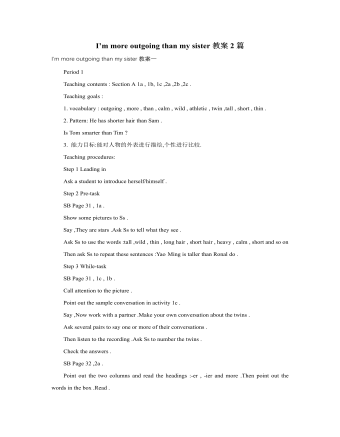
人教版新目标初中英语八年级上册I’m more outgoing than my sister教案2篇
1 交通工具的比较此活动为小组活动。学生通过讨论找出到达某一城市可乘坐的各种交通工具,并选择最佳出行方式。Teacher:We’re going to Shanghai. How many ways can we use to get there? Yes, there are four ways: by bus, by plane, by train, by ship. Please discuss how you are going to get there.操作建议:(1)学生以小组为单位展开活动,谈论本组所选择的交通工具。(2)各组选代表向全班汇报,阐述本组所选择的交通工具的利和弊。完成任务所需要的语言结构:We can go there by ship. It’s more comfortable and cheaper than any other transportation.We can go there by bus. It’s cheaper but it takes longer time.2 哪个城市更合适?此活动具有挑战性。假设中国要举行2014年世界杯足球赛,分别从历史,人文,天气等方面对各城市(北京,大连,上海,昆明)进行比较,选择最佳举办城市。T: Imagine China is holding the 2014 FIFA World Cup. Which city do you think is the best for the World Cup, Beijing, Dalian, Shanghai or Kunming? Let’s work in groups. If you choose Beijing, please join the Team Red. If you chose Dalian, please join the Team White. If you choose Shanghai, please join the Team Blue. If you choose Kunming, please join the Team Green. Please show us its advantages. Then let’s see which team will win.
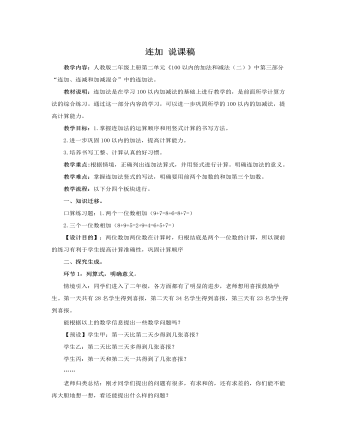
人教版新课标小学数学二年级上册连加 说课稿
教材说明:连加法是在学习100以内加减法的基础上进行教学的,是前面所学计算方法的综合练习。通过这一部分内容的学习,可以进一步巩固所学的100以内的加减法,提高计算能力。教学目标:1.掌握连加法的运算顺序和用竖式计算的书写方法。2.进一步巩固100以内的加法,提高计算能力。3.培养书写工整、计算认真的好习惯。教学重点:根据情境,正确列出连加法算式,并用竖式进行计算。明确连加法的意义。教学难点:掌握连加法竖式的写法,明确要用前两个加数的和加第三个加数。教学流程:以下分四个板块进行。一、知识迁移。口算练习题:1.两个一位数相加(9+7=8+6=8+7=)2.三个一位数相加(8+9+5=2+9+4=6+5+7=)【设计目的】:两位数加两位数在计算时,归根结底是两个一位数的计算,所以课前的练习有利于学生提高计算准确性,巩固计算顺序
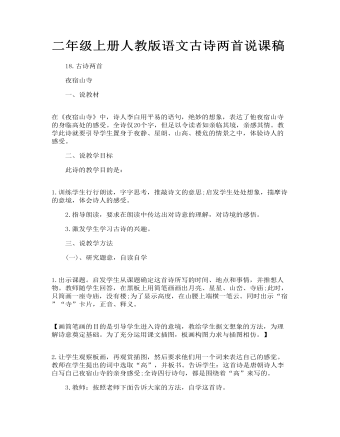
二年级上册人教版语文古诗两首说课稿
二、说教学目标 此诗的教学目的是: 1.训练学生行行朗读,字字思考,推敲诗文的意思;启发学生处处想象,揣摩诗的意境,体会诗人的感受。 2.指导朗读,要求在朗读中传达出对诗意的理解,对诗境的感悟。 3.激发学生学习古诗的兴趣。 三、说教学方法 (一)、研究题意,自读自学 1.出示课题。启发学生从课题确定这首诗所写的时间、地点和事情,并推想人物。教师随学生回答,在黑板上用简笔画画出月亮、星星、山峦、寺庙;此时,只简画一座寺庙,没有楼;为了显示高度,在山腰上端横一笔云。同时出示“宿”“寺”卡片,正音、释义。 【画简笔画的目的是引导学生进入诗的意境,教给学生据文想象的方法,为理解诗意奠定基础。为了充分运用课文插图,板画构图力求与插图相仿。】 2.让学生观察板画,再观赏插图,然后要求他们用一个词来表达自己的感觉。教师在学生提出的词中选取“高”,并板书。告诉学生:这首诗是唐朝诗人李白写自己夜宿山寺的亲身感受;全诗四行诗句,都是围绕着“高”来写的。
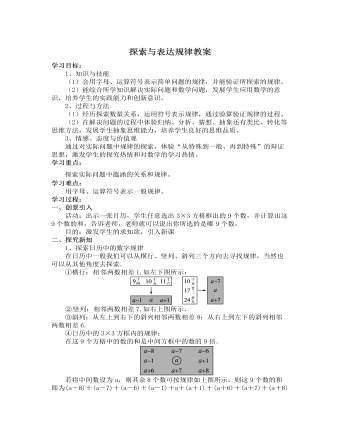
北师大初中七年级数学上册探索与表达规律教案2
学习目标:1、知识与技能(1)会用字母、运算符号表示简单问题的规律,并能验证所探索的规律。(2)能综合所学知识解决实际问题和数学问题,发展学生应用数学的意识,培养学生的实践能力和创新意识。2、过程与方法(1)经历探索数量关系,运用符号表示规律,通过验算验证规律的过程。(2)在解决问题的过程中体验归纳、分析、猜想、抽象还有类比、转化等思维方法,发展学生抽象思维能力,培养学生良好的思维品质。3、情感、态度与价值观通过对实际问题中规律的探索,体验“从特殊到一般、再到特殊”的辩证思想,激发学生的探究热情和对数学的学习热情。学习重点:探索实际问题中蕴涵的关系和规律。学习难点:用字母、运算符号表示一般规律。学习过程:一、创景引入活动:出示一张月历,学生任意选出3×3方格框出的9个数,并计算出这9个数的和,告诉老师,老师就可以说出你所选的是哪9个数。
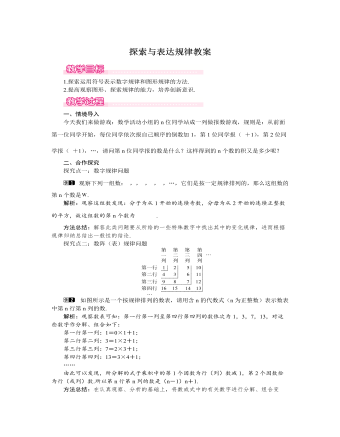
北师大初中七年级数学上册探索与表达规律教案1
(1)依照此规律,第20个图形共有几个五角星?(2)摆成第n个图形需要几个五角星?(3)摆成第2015个图形需要几个五角星?解析:通过观察已知图形可得:每个图形都比其前一个图形多3个五角星,根据此规律即可解答.解:(1)根据题意得,第1个图中,五角星有3个(3×1);第2个图中,五角星有6个(3×2);第3个图中,五角星有9个(3×3);第4个图中,五角星有12个(3×4);∴第n个图中有五角星3n个.∴第20个图中五角星有3×20=60个.(2)摆成第n个图形需要五角星3n个.(3)摆成第2015个图形需要6045个五角星.方法总结:此题首先要结合图形具体数出几个值,注意由特殊到一般的分析方法.此题的规律为摆成第n个图形需要3n个五角星.三、板书设计教学过程中,强调学生自主探索和合作交流,经历观察、操作、验证、归纳、分析、猜想、抽象、积累、类比、转化等思维过程,从中获得数学知识与技能,体验教学活动的方法,同时升华学生的情感态度和价值观.
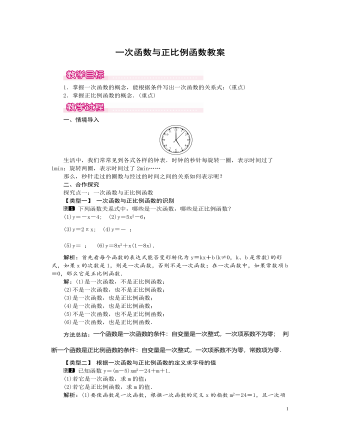
北师大初中数学八年级上册一次函数与正比例函数1教案
煤的价格为400元/吨,生产1吨甲产品除需原料费用外,还需其他费用400元,甲产品每吨售价4600元;生产1吨乙产品除原料费用外,还需其他费用500元,乙产品每吨售价5500元.现将该矿石原料全部用完,设生产甲产品x吨,乙产品m吨,公司获得的总利润为y元.(1)写出m与x的关系式;(2)写出y与x的函数关系式.(不要求写自变量的取值范围)解析:(1)因为矿石的总量一定,当生产的甲产品的数量x变化时,那么乙产品的产量m将随之变化,m和x是动态变化的两个量;(2)题目中的等量关系为总利润y=甲产品的利润+乙产品的利润.解:(1)因为4m+10x=300,所以m=150-5x2.(2)生产1吨甲产品获利为4600-10×200-4×400-400=600(元);生产1吨乙产品获利为5500-4×200-8×400-500=1000(元).所以y=600x+1000m.将m=150-5x2代入,得y=600x+1000×150-5x2,即y=-1900x+75000.方法总结:根据条件求一次函数的关系式时,要找准题中所给的等量关系,然后求解.
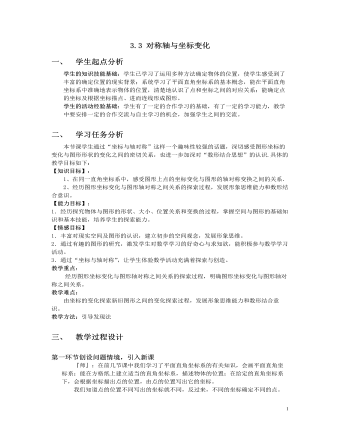
北师大初中数学八年级上册轴对称与坐标变化2教案
8.一束光线从点A(3,3)出发,经过y轴上点C反射后经过点B(1,0)则光线从A点到B点经过的路线长是( )A.4 B.5 C.6 D.7第四环节课堂小结1、关于y轴对称的两个图形上点的坐标特征:(x , y)——(- x , y)2、关于x轴对称的两个图形上点的坐标特征:(x , y)——(x , - y)3、关于原点对称的两个图形上点的坐标特征:(x , y)——(- x , -y)第五环节布置作业习题3.5 1,2,3四、 教学反思通过“坐标与轴对称”,经历图形坐标变化与图形的轴对称之间的关系的探索过程, 掌握空间与图形的基础知识和基本技能,丰富对现实空间及图形的认识,建立初步的空间观念,发展形象思维,激发学生对数学学习的好奇心与求知欲,学生能积极参与数学学习活动;积极交流合作,体验数学活动充满着探索与创造。教学中务必给学生创造自主学习与合作交流的机会,留给学生充足的动手机会和思考空间,教师不要急于下结论。事先一定要准备好坐标纸等,提高课堂效率。
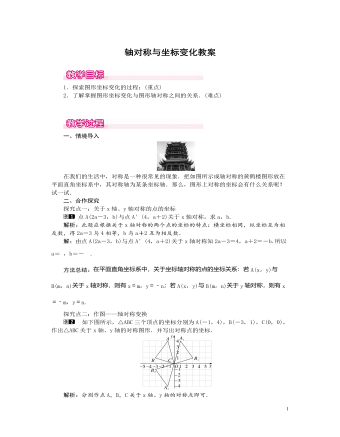
北师大初中数学八年级上册轴对称与坐标变化1教案
解析:从各点的位置可以发现A1(1,0),A2(1,1),A3(-1,1),A4(-1,-1),A5(2,-1),A6(2,2),A7(-2,2),A8(-2,-2),A9(3,-2),A10(3,3),A11(-3,3),A12(-3,-3),….仔细观察每四个点的横、纵坐标,发现存在着一定规律性.因为2015=503×4+3,所以点A2015在第二象限,纵坐标和横坐标互为相反数,所以A2015的坐标为(-504,504).故填(-504,504).方法总结:解决此类题常用的方法是通过对几种特殊情况的研究,归纳总结出一般规律,再根据一般规律探究特殊情况.三、板书设计轴对称与坐标变化关于坐标轴对称作图——轴对称变换通过本课时的学习,学生经历图形坐标变化与图形的轴对称之间的关系的探索过程,掌握空间与图形的基础知识和基本作图技能,丰富对现实空间及图形的认识,建立初步的空间观念,发展形象思维,激发数学学习的好奇心与求知欲.教学过程中学生能积极参与数学学习活动,积极交流合作,体验数学活动的乐趣.
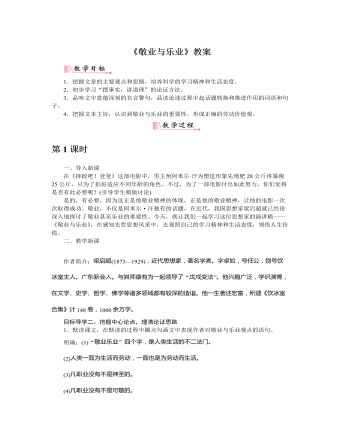
部编版语文九年级上册《敬业与乐业》教案
一、导入新课在《摔跤吧!爸爸》这部电影中,男主角阿米尔·汗为塑造形象先增肥28公斤再暴瘦25公斤,只为了拍好适应不同年龄的角色。不过,为了一部电影付出如此努力,你们觉得是否有此必要呢?(引导学生稍做讨论)是的,有必要,因为这正是他敬业精神的体现,正是他的敬业精神,让他的电影一次次取得成功。敬业,不仅是阿米尔·汗独有的话题,在近代,我国思想家梁启超就已经很深入地探讨了敬业甚至乐业的重要性。今天,就让我们一起学习这位思想家的演讲稿——《敬业与乐业》,在感知先哲思想风采中,去观照自己的学习精神和生活态度,领悟人生价值。二、教学新课目标导学一:认识作者作者简介:梁启超(1873—1929),近代思想家,著名学者。字卓如,号任公,别号饮冰室主人。广东新会人。与其师康有为一起领导了“戊戌变法”。他兴趣广泛,学识渊博,在文学、史学、哲学、佛学等诸多领域都有较深的造诣。他一生著述宏富,所遗《饮冰室合集》计148卷,1000余万字。
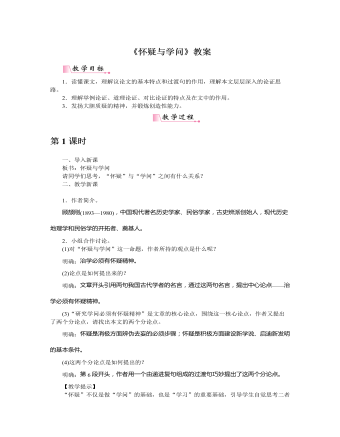
部编版语文九年级上册《怀疑与学问》教案
一、复习回顾、引入新课上节课,我们学习了《怀疑与学问》的内容,也学习了议论文结构的基本特征以及常用的论证方法,这节课我们重点学习议论文在论证论点过程中说理的层次,还要进一步理解议论文分析事理透辟,语言严密的特点。二、教学新课目标导学一:探究说理的层次,明确各段之间的关系请同学们细读课文,边读边思考句与句之间的关系,分组完成以下问题。1.本文论点是“治学必须有怀疑精神”,作者是如何阐述怀疑精神的?明确:对怀疑精神作者阐述得明确而透彻:所谓疑就是决不轻信,经过思考,分清是非,再决定信与不信;进而把怀疑科学地分为“怀疑”“思索”“辨别”三步。2.结合课文思考:作者是如何阐述“从怀疑到创新”这一治学过程的?明确:作者在进一步论证“怀疑是建设新学说、启迪新发明的基本条件”时,又把怀疑到创新的治学过程分析为“怀疑、辩论、评判、修正、创新”。作者通过举例、正反说理,使内容阐述得鞭辟入里,无懈可击。
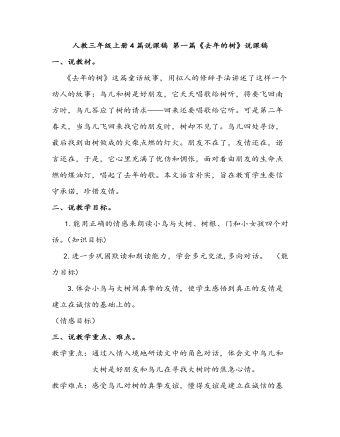
人教版三年级上册语文说课稿
二、说教学目标。 1.能用正确的情感来朗读小鸟与大树、树根、门和小女孩四个对话。(知识目标) 2.进一步巩固默读和朗读能力,学会多元交流,多向对话。 (能力目标) 3.体会小鸟与大树间真挚的友情,使学生感悟到真正的友情是建立在诚信的基础上的。
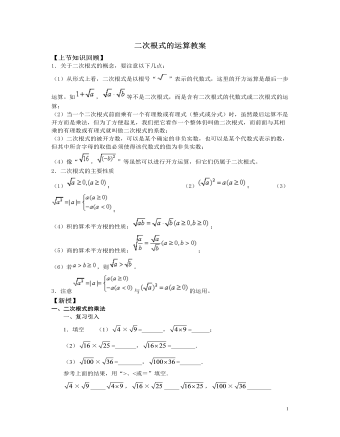
北师大初中数学八年级上册二次根式的运算2教案
1.关于二次根式的概念,要注意以下几点:(1)从形式上看,二次根式是以根号“ ”表示的代数式,这里的开方运算是最后一步运算。如 , 等不是二次根式,而是含有二次根式的代数式或二次根式的运算;(2)当一个二次根式前面乘有一个有理数或有理式(整式或分式)时,虽然最后运算不是开方而是乘法,但为了方便起见,我们把它看作一个整体仍叫做二次根式,而前面与其相乘的有理数或有理式就叫做二次根式的系数;(3)二次根式的被开方数,可以是某个确定的非负实数,也可以是某个代数式表示的数,但其中所含字母的取值必须使得该代数式的值为非负实数;(4)像“ , ”等虽然可以进行开方运算,但它们仍属于二次根式。2.二次根式的主要性质(1) ; (2) ; (3) ;(4)积的算术平方根的性质: ;(5)商的算术平方根的性质: ;

